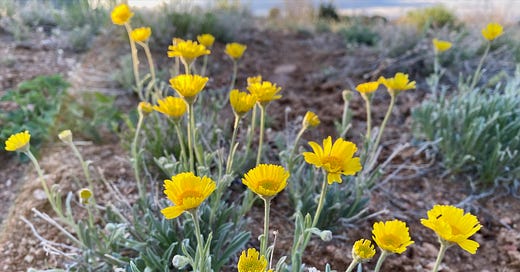Good morning, Friends! Today I want to take you along on my dawn walking meditation through the high desert near my house. We’ll meet two wildflowers just beginning to bloom now: Perky Sue and Banana Yucca.
I think of these native plants as neighbors who weave the natural community of this dry grassland dotted with piñon pine and juniper trees. As humans come and go, these wildflowers are constants, appearing each year no matter the conditions, and co-creating these landscapes through their relationships with each other, and with all of the other lives that animate these arid spaces, from microscopic algae in the soil and big-jawed harvester ants to singing coyotes and migrating sandhill cranes.
I’ll introduce each plant with a short video from my “Weekly Wildflower” series—I shot both on my walk this morning. And I’ve added some written commentary to expand on each video. Join me, and enjoy!
Perky Sue
Perky Sue, or Tetraneuris argentea in the language of science, is a member of the daisy family, known for their “composite” flowers, meaning what looks like a single flower is actually many flowers packed together into a single head.
Perky Sue has classic daisy-family flower heads, with a center made of disk flowers (flowers without petals) spiraling out from the middle and ray flowers, each with a long petal-like extension, growing around the edges. Grouping many small flowers in a composite head is a way to attract the attention of pollinators, and it gives them an easy “landing pad” from which to feed.
In the video, I mentioned small native bees and butterflies as pollinators; I should have also included small flies and beetles.
The seeds of Perky Sue are winter food for pine siskins, streaky cousins of goldfinches, and bushtits, tiny seed-eating birds with long tails who gather in flocks of dozens in winter, and forage together, bouncing enthusiastically from plant to plant like aerial pinballs, chattering in their high voices.
Banana Yucca
With their rosette of stiff-spiked evergreen leaves, Banana Yuccas (Yucca baccata) are an architectural plant year-round, and wonderful additions to arid-country gardens and landscaping. And then, as an early spring surprise, the leaf rosettes sprout a flower stalk like an oversized asparagus spear, which bursts into bloom as lush tower of waxy, bell-shaped blooms.
In the video, when I was describing pronuba moths pollinating the flowers that the moth “brings pollen to the stamens”—wrong! That error is a result of my brain being a bit carb-challenged before eating breakfast.
What actually happens is that the moth carries pollen from another Bbanana Yucca plant to the pistil, the female part of the flower, pollinating it, before she lays eggs by drilling into the ovaries at the base of the pistil. Then as she backs out of the flower, her furry body picks up pollen from the anthers, which she carries on to the next flower she will pollinate.
Two Lessons: Resilience and Community
One thing I hope you take from these videos is the miracle of wildflowers blooming in a severely dry spring during more than two decades of drier-than-normal years. (Yes, we’re in a mega-drought.)
These plants evolved in an arid place (our average annual precipitation is 8 to 10 inches a year, less than an inch a month), so they know how to use water when they have it and hunker down when they don’t. Blooming is water-intensive, not just in the cell division that makes flowers, but in making nectar and pollen to reward their pollinating partners.
That these plants are blooming in a spring when we have received less than two inches of moisture since late January seems miraculous to me, and it gives me hope about the resilience of this planet as a whole.
The other thing I hope you take from these amazing plants is that they live in relationship with other species. They are not rugged individuals competing against all others for a place in the world.
Rather, they depend on pollinators—insects, birds, bats and lizards, among others—to ensure reproduction and the next generation. They depend on microbes in the soil to provide nutrients, fungal threads to help them harvest scarce water and share food, birds to eat grazing insects, and many others.
Nature is a community, and cooperation between vastly diverging lives is an important part in keeping that community healthy. We humans could use to emulate that.
Blessings to you all!





I love this! Thanks for teaching us about your plant friends.
Loved learning about Perky Sue. Been busy lately and missed my weekly dose of wildflowers. Thanks for brightening my rainy day.